THE TIERII MODELING APPROACH FOR AQUATIC EXPOSURE ASSESSMENT IN THE U.S. EPA OFFICE OF PESTICIDE PROGRAMS
James Lin, Dirk Young, and Ian Kennedy. OPP/EFED, US EPA, Washington, DC.
As a continued effort to reduce the uncertainties in aquatic exposure assessment, Environmental Fate and Effects Division (EFED) in the Office of Pesticide Programs (OPP) has begun a new initiative to move to a tiered approach to ecological risk assessments. The approach developed includes probabilistic tools and methods for use in the pesticide regulatory process, which would address the magnitude and probability of risk and provide an estimate of the associated uncertainty. The approach proceeds through four levels of analysis or refinement, from simple deterministic quotients through a general probabilistic analysis, to an issue-specific probabilistic assessment in the highest levels. This presentation provides an update on the recent Tier II modeling approach. In addition to standardizing various modeling scenarios for PRZM (Pesticide Root Zone Model) to assess aquatic exposure associated with pesticide application to different crops in different regions, the Tier II approach will also consider the variable volume water body as the standard farm pond in EXAMS (Exposure Analysis Modeling System).
On this Page
- Poster Outline
- Level 2 Modeling Approach
- Schematic of Level 2 Models
- PRZM - Pesticide Root Zone Model
- EXAMS - Exposure Analysis Modeling System
- AgDRIFT - Spray Drift Model
- Development of Modeling Scenarios
- Major Land Resources Areas and Associated Meteorological Stations
- Some of the Modeling Scenarios
- Reference for the Modeling Scenarios
- EFED's Aquatic Exposure Shell
- Consideration of Variable Pond Volume
- Variable Volume Water Body
Poster Outline
Describe the current level 2 modeling approach for aquatic exposure assessment.
Development of Standard Scenarios and EFED's shell for aquatic exposure assessment.
Consideration of variable volume water body as the standard farm pond.
Level 2 Modeling Approach
To characterize temporal variations based on the historical weather pattern for a specific area.
To provide the model estimates of pesticide loadings to the standard pond and the resulting EECs from one reasonable worst case scenario over multiple years.
Runoff/erosion estimations with PRZM
Surface water concentration estimations with EXAMS
Schematic of Level 2 Models
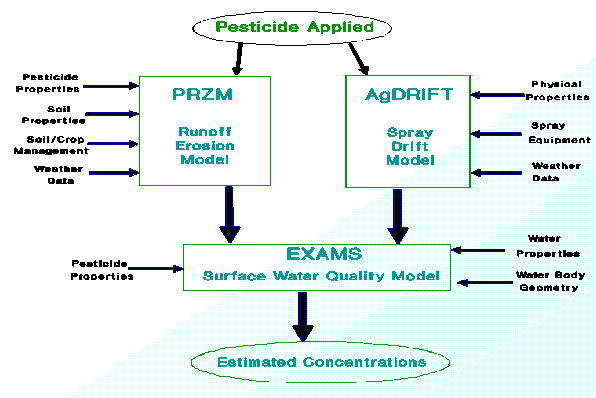
Schematic of Level 2 Models
PRZM - Pesticide Root Zone Model
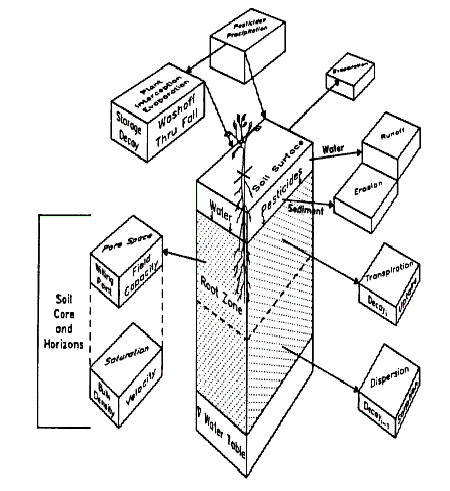
PRZM - Pesticide Root Zone Model
Field scale - homogeneous soil, crop, and land use
To simulate chemical movement in the unsaturated soil system within and below plant root zone
Hydrology components:
Runoff (SCS curve number approach)
Erosion (modified soil loss equation, MUSLE)
Evapotranspiration (pan data or air temperature)
Percolation (water routing technique)
Chemical transport components:
- Plant Uptake, Foliar Wash-off and Decay
- Surface Runoff and Erosion, Decay, Volatilization
- Advection and Diffusion, Adsorption (Retardation)
EXAMS - Exposure Analysis Modeling System
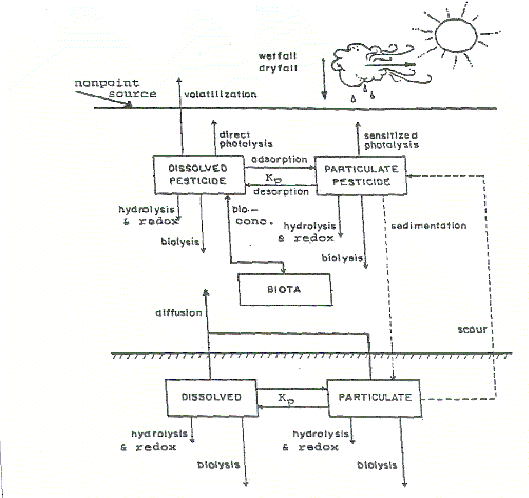
EXAMS - Exposure Analysis Modeling System
Chemical Fate Processes:
Ionic and Sorptive Equilibria
Advective and Dispersive Transport
Transformation Processes:
Volatilization, Hydrolysis, Photochemical Reactions,
Redox Reactions, and Microbial Biotransformation.
To provide analyses of chemicals (and their degradates) in the aquatic systems -
fate: spatial distributions of the chemicals;
persistence: the persistence of the chemicals;
exposure: EECs @ 0, 4, 21, 60, and 90-day
AgDRIFT - Spray Drift Model
The modeling product of the cooperative research agreement between EPA, USDA, and SDTF (Spray Drift Task Force)
AgDRIFT estimates downwind deposition from liquid spray applications
AgDRIFT is three models rolled into one:
Aerial: A mechanistic model (derived from FSCBG) which has been validated against field data.
Ground Boom: Empirically developed deposition curves based on on 4 application categories. Future improvements to include tolerance bounds.
Orchard Airblast: Empirically developed deposition curves based on eight kinds of orchards and orchard groupings. Future improvements to include tolerance bounds
Development of Modeling Scenarios
Select location with high expected rainfall within crop growing areas
Select soil with high expected runoff and soil erosion
Utilize actual measured weather data from U.S. National Weather Service
Use multiple years (36) of weather for temporal probabilistic assessment at the site
Major Land Resources Areas and Associated Meteorological Stations
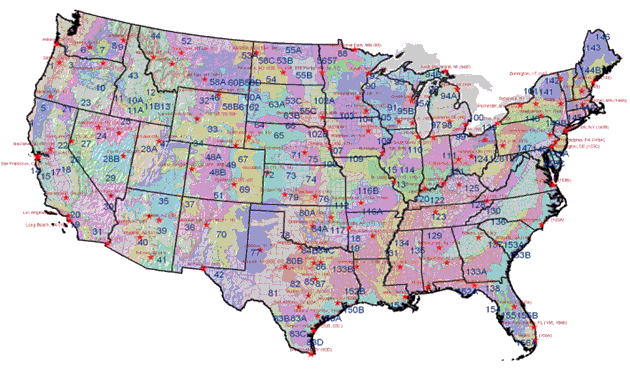
Major Land Resources Areas and Associated Meteorological Stations
(Enlarged Map)
Some of the Modeling Scenarios
| STATE | CROP | MLRA1 | SOIL |
|---|---|---|---|
| CA | Alfalfa | 17/18 | Sacramento |
| CA | Citrus | 17 | Exeter |
| CA | Corn | 18 | Madera |
| CA | Cotton | 17 | Twisselman |
| CA | Fruit (non-citrus) | 17/18 | Exeter |
| CA | Grape | 17/18 | San Joaquin |
| CA | Sugarbeet | 17/18 | Exeter |
| CA | Tomatoes | 17/18 | Stockton |
| CA | Walnuts / Almonds | 17/18 | Mateca |
| FL | Cabbage | 156B | Riviera |
| FL | Citrus | 156A | Wabasso |
| FL | Cucumber | 156B | Riviera |
| FL | Sugarcane | 156A | Wabasso |
| FL | Sweet Corn | 156B | Riviera |
| FL | Turf | 156A | Adamsville |
| IL | Corn | 108 | Adair |
| LA | Sugarcane | 131 | Commerce |
| MN | Alfalfa | 56 | Bearden |
| MN | Sugarbeet | 56 | Adair |
| MS | Corn | 134 | Grenada |
| MS | Cotton | 131 | Loring |
| MS | Soybean | 134 | Loring |
| NC | Alfalfa | 130 | Helena |
| NC | Apple | 130 | Hayesville |
| NC | Corn - E | 133A | Craven |
| NC | Corn - W | 130 | Chewacla |
| NC | Cotton | 133A | Boswell |
| NC | Peanut | 130 | Craven |
| NC | Tobacco | 133A | Norfolk |
| ND | Corn | 56 | Bearden |
| ND | Wheat | 56 | Bearden |
| OR | Apple | 2 | Cornelius |
| OR | Berries | 2 | Woodburn |
| OR | Christmas Trees | 2 | Pilchuck |
| OR | Filberts | 2 | Cornelius |
| OR | Grass Seed | 2 | Dayton |
| OR | Hops | 2 | Woodburn |
| OR | Mint | 2 | Newberg |
| OR | Sweetcorn | 2 | Woodburn |
| OR | Vegetable (non-tuber) / Snapbeans | 2 | Dayton |
| OR | Wheat | 2 | Bashaw |
| PA | Alfalfa | 148 | Glenville |
| PA | Apple | 148 | Elioak |
| PA | Corn | 148 | Hagerstown |
| PA | Turf | 148 | Gkenville |
| PA | Vegetable / tomatoes | 148 | Glenville |
| TX | Alfalfa | 87 | Lufkin |
| TX | Corn | 87 | Axtell |
| TX | Cotton | 86 | Crockett |
| TX | Sorghum | 87 | Axtell |
| TX | Wheat | 86 | Crockett |
Reference for the Modeling Scenarios
A complete discussion of the purpose and methods of scenario standardization can be found in the Preliminary OP Cumulative Risk Assessment as an appendix located on the following web page:
https://www.epa.gov/pesticides/cumulative/pra-op/
EFED's Aquatic Exposure Shell
Developed by Dr. Ian Kennedy
It is a graphical interface that facilitates putting chemical- and use- specific input values into the proper positions in the PRZM input and the EXAMS chemical files.
The interface was created using Perl and Tk, publicly available programming, and requires Perl Tk to run.
It is capable of simulating exposure for index reservoir (in drinking water assessment) and standard farm pond (in ecological aquatic exposure assessment).
EFED's Aquatic Exposure Shell
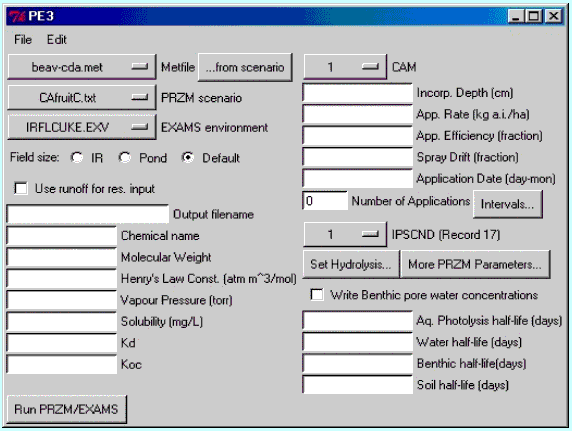
Consideration of Variable Pond Volume
Developed by Dr. Dirk Young
Implemented in the MATLAB environment.
New Additions to Water Body
Variable volume water body
Parameters can change on daily basis (e.g., temperature, wind speed, dissipation rates)
Daily weather data from met files
Solved analytically
Variable Volume Water Body

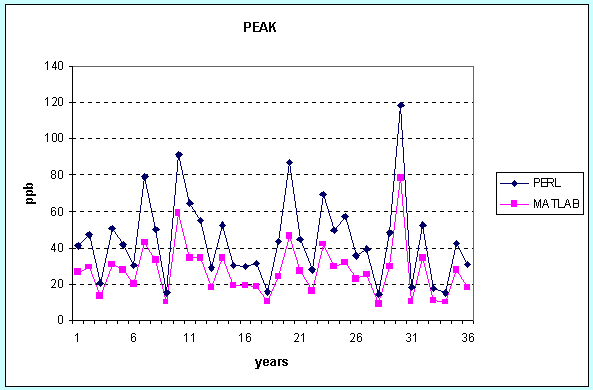
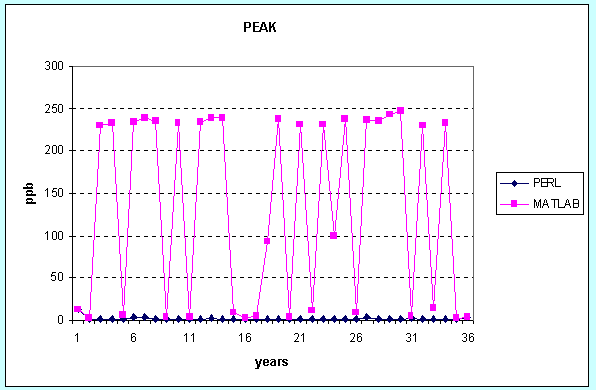
Variable Volume Water Body
![[logo] US EPA](../gif/logo_epaseal.gif)